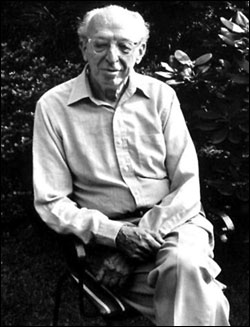“The way to write American music is simple,” composer/critic Virgil Thomson once said in his usual cut-through-the-b.s. style. “All you have to do is to be an American and then write any kind of music you wish.” But not every composer who came of age in the 1920s and ’30s was so content to dismiss the question. Their search for an answer resulted in some enduring works, none more so than Aaron Copland’s Third Symphony (heard this weekend in a Seattle Symphony concert opening Thursday, March 20; call 215-4747 for information).
No earlier American composers, whatever the local color of their music, were as self-conscious of carving out a place for the United States in the “serious” music tradition as Copland and his peers. From the start, Copland planned his Third as a big statement, including as its heart his popular “Fanfare for the Common Man” from 1942, a piece whose only rival as an icon of Americanaat least among instrumental musicis Sousa’s “Stars and Stripes Forever.”
The only statement Copland ever made about the symphony’s meaning, however, was that it reflected “the euphoric spirit of the country at the time”that is, 1946, when the Boston Symphony premiered it. But he started work on it during World War II, which makes “euphoric” a puzzling term. Later, as if to admit that this was a facile explanation, Copland coyly but wisely declined to limit his music by attaching labels: “I could invent an ideological basis for the Third Symphony. But if I did, I’d be bluffing”grasping for descriptions, like “euphoric,” that in reality “played no role at the moment of creation.”
The symphony is cast in the traditional four movements, but the movement divisions seem less significant than the cycle of three musical moods Copland juggles throughout. Much of the music is spacious and serene, with long, arching melodies in which Copland, a child of Russian-Jewish immigrants, suggests not only vast space and distant horizons but unlimited dreams and possibilities. Some passages resemble a brassy, aggressive proclamation; the work’s bombast earned Copland some criticism, but it befits a nation that had become a world power in its adolescence. Other passages are frenetic and percussive, perhaps jazzily syncopated, exploiting the shrill upper registers of the orchestramusic of machine-age urbanity.
Copland masterfully plays these moods against each other. One favorite rhetorical device is to build a huge climax and interrupt it with a sudden quietness. But the tension of the buildup isn’t dissipated; it persists as an uneasy undertone. Even more skillful is the way Copland blends and superimposes these three moods in the finaleit opens with a quiet woodwind pre-echo of “Fanfare,” which seems to dissolve and color the entire movement. But each of these moods has a dark side: The spaciousness becomes bleakness, the brass aggression can turn from heroic triumph to (militaristic?) glowering in a moment, while the skittering high music sometimes sounds feverish and anxiety-ridden.
Of course, if the symphony had one meaning that could be pinned down in a sentence, it wouldn’t have lasted. Leonard Bernstein, one of the symphony’s foremost interpreters, compared it to “the Washington Monument or the Lincoln Memorial,” but unlike either, it retains its hold on listeners as a reminder of both the dark and the light of American experience. It’s Copland’s longest orchestral work, a stylistic culmination not only for him but for American music: As if on cue, composers in the ’50s and ’60s turned away from this sort of overt Americana, partly because changes in our culture demanded new musical expression. But, no doubt, composers also realized that Copland’s summation couldn’t be bettered.







